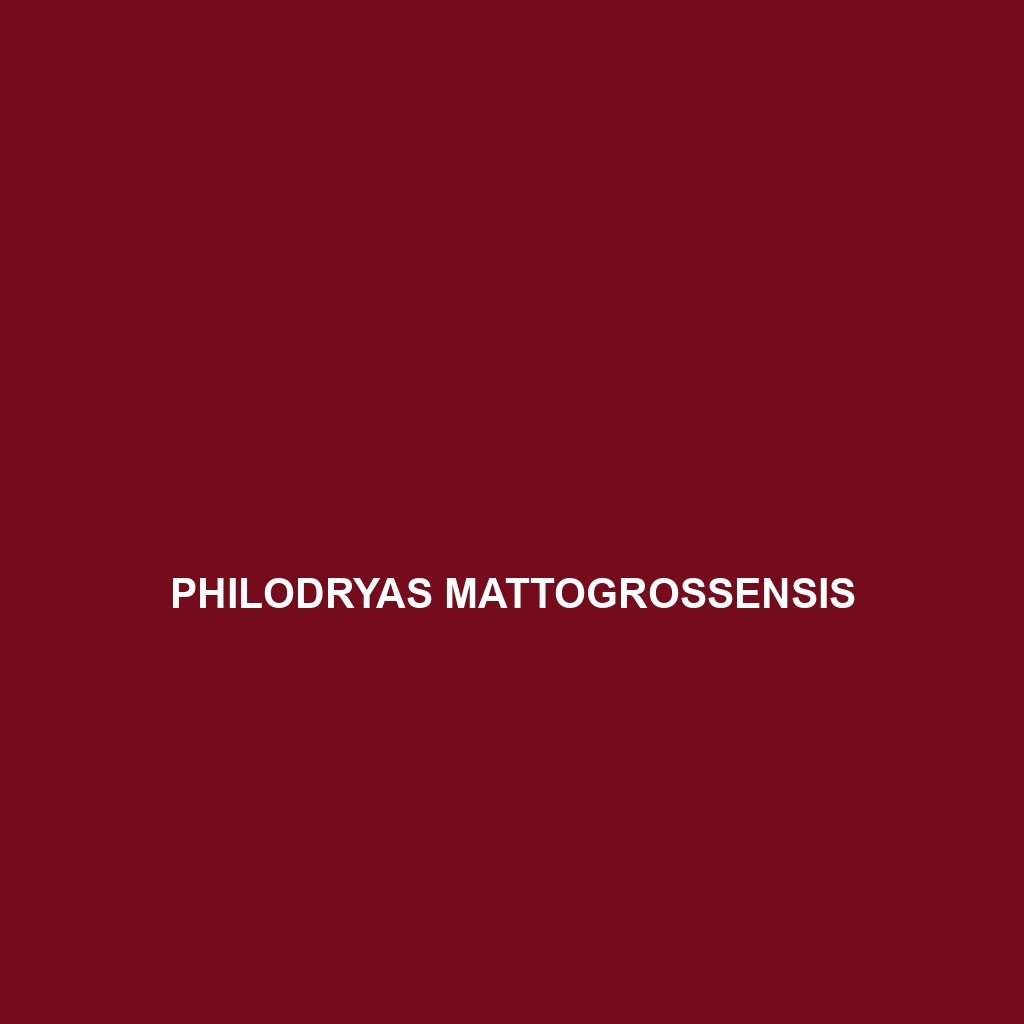Common Name
Philodryas mattogrossensis
Scientific Name
Philodryas mattogrossensis
Habitat
The Philodryas mattogrossensis, commonly known as the Mato Grosso Green Snake, is primarily found in the lush environments of South America, with a particular focus on the Amazon Rainforest and parts of the Pantanal region. This species thrives in humid, tropical rainforests characterized by a warm and wet climate. The forests provide dense canopy coverage, allowing the snake to utilize branches and foliage for hunting and protection from predators. Additionally, Philodryas mattogrossensis can also inhabit adjacent areas such as savannas and clearings, where they can bask in the sun. These diverse habitats not only deliver ample prey but also play a crucial role in the survival of this green snake.
Physical Characteristics
The Philodryas mattogrossensis is an elongated snake, reaching an average length of 1.2 meters (approximately 4 feet), although some individuals can grow up to 1.5 meters (around 5 feet). Its slender and agile body is typically adorned with a vibrant green coloration, providing excellent camouflage among the leaves and branches of its habitat. A distinguishing feature of this species is its slightly flattened head, which is more prominent than its neck, giving it a triangular appearance. The underside is usually a lighter yellow or cream color, with occasional dark specks that help in blending with the forest floor. This coloration not only aids in concealment but also serves as a warning to potential predators of its mild toxicity.
Behavior
The Philodryas mattogrossensis exhibits a primarily arboreal lifestyle, often seen gliding along branches or basking in the sun. This species is generally diurnal, becoming active during the day to hunt and forage. It exhibits solitary behavior, coming together only during the mating season. One of the captivating aspects of their behavior is their unique hunting strategy; they are known to utilize ambush techniques, remaining motionless in wait for prey to come within striking distance. Additionally, Philodryas mattogrossensis has been observed displaying a variety of social interactions during the mating rituals, with males engaging in combat displays to attract females.
Diet
The diet of Philodryas mattogrossensis consists mainly of small mammals and birds, which classifies it as a carnivore. This snake is an efficient predator, utilizing its keen eyesight and quick reflexes to capture prey. Moreover, it has been documented preying on reptiles and amphibians. Its feeding pattern typically involves ambushing unsuspecting prey, employing constriction methods to subdue them. The Mato Grosso Green Snake’s ability to adapt its hunting techniques in various ecological conditions contributes significantly to its survival in a diverse diet environment.
Reproduction
The reproductive cycle of Philodryas mattogrossensis is an intriguing facet of its biology. Mating usually occurs during the wet season, around November to January, when temperatures and humidity levels provide optimal conditions for reproductive success. After a gestation period lasting about 60 to 70 days, females give birth to live young, a trait known as ovoviviparity. Offspring typically range from 4 to 12 in number, depending on the female’s health and environmental factors. Parental care is minimal post-birth as the young snakes are born fully formed and must quickly learn to hunt and fend for themselves.
Conservation Status
As of now, the Philodryas mattogrossensis is classified as ‘Least Concern’ by the IUCN Red List. However, habitat destruction due to deforestation and agricultural expansion poses ongoing threats to its population. Conservation efforts are gradually gaining traction to protect the remaining habitats of this species. Various NGOs and governmental bodies are actively working towards habitat preservation and promoting awareness about the importance of maintaining the ecological balance in regions where the Mato Grosso Green Snake resides.
Interesting Facts
The Philodryas mattogrossensis possesses mild venom, which it utilizes primarily for subduing prey rather than for defense against predators. Interestingly, these snakes have the ability to change colors slightly, especially when basking in different lighting conditions. Their vibrant green hue can appear more vivid in direct sunlight, enhancing their stealth as they hunt. Furthermore, the Mato Grosso Green Snake is often mistaken for similar looking species; however, its unique combative display during mating season can be a telltale sign distinguishing it from others.
Role in Ecosystem
The Philodryas mattogrossensis plays a vital role in its ecosystem as a predator, helping control the populations of its prey species. This balance is crucial for the health of the forest, as it maintains the food chain integrity. Additionally, the presence of the Mato Grosso Green Snake indicates a healthy environment, as these snakes require specific habitat conditions to thrive. In its role, this species also acts as a prey item for larger predators, thus contributing to the natural cycling of energy within the ecosystem.
